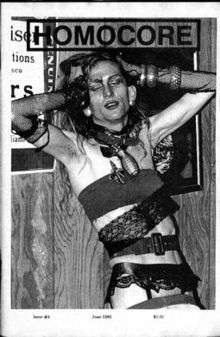Jerome Caja
| Jerome Caja | |
|---|---|
| Born |
January 20, 1958 Cleveland, Ohio |
| Died |
November 3, 1995 (aged 37) San Francisco, California |
| Nationality | American |
| Education |
Cleveland State University (B.F.A.) San Francisco Art Institute (M.F.A.) |
| Known for |
mixed media performance art |
| Movement | Queercore |
Jerome Caja (1958-1995) was an American mixed-media painter and Queercore performance artist in San Francisco, California in the 1980s and early 1990s.[1]

Early life and education
Caja was born on January 20, 1958 in Cleveland, Ohio and raised in a large strict Catholic family. One of 11 sons, Caja called it a family of jocks,[2] although he himself was a frail sickly child. Caja attended Cleveland State University where he earned a Bachelor of Fine Arts degree in 1984. He then moved to San Francisco to continue his art education and graduated with a Master of Fine Arts degree from the San Francisco Art Institute in 1986.[3]
Career
In the late 1980s, Caja became a well-known artistic personality within the radical gay scene in San Francisco.[4] Caja performed as a drag queen and go-go dancer in San Francisco's queer punk nightclubs,[3] where his performance art has been described as "post-apocalyptic deconstructive drag."[4] In one Easter performance at Club Uranus, Caja in drag performed an elaborate reenactment of the crucifixion and resurrection of Jesus.[5]
Caja crafted miniature mixed-media artworks which he created from everyday materials, especially those used by drag queens such as nail polish, sequins, lace and glitter.[3] Many of Caja's works were influenced by Catholic iconography and satirized Christian morality.[1] Professor of Communication Fred Turner described Caja's paintings as "fragments of a private allegory -- often dizzyingly grotesque, but also glorious, gentle and sad."[6]
Death
According to Caja, he tested positive for HIV around 1989 and began to show symptoms of sickness around 1992.[7] In September and August 1995, the Archives of American Art recorded an oral history interview with Caja. He died of AIDS in San Francisco on November 3, 1995. His memorial service was held at the Hole in the Wall gay bar in South of Market, San Francisco.[4]
Artworks
The San Francisco Museum of Modern Art (SFMOMA) twice provided exhibits of paintings by Caja. Before his death, Caja gifted his unsold artworks to the SFMOMA.[8] Caja's personal papers and effects are archived in the Smithsonian Institution.[9]
References
- 1 2 Hendrickson, Daniel (2006). Davis A. Gerstner, ed. Routledge International Encyclopedia of Queer Culture. Routledge. p. 117. ISBN 978-0-415-56966-8.
- ↑ Whiting, Sam (March 23, 1995). "A Dabbler In Minutiae". SFGate. Retrieved 29 June 2015.
- 1 2 3 Bonetti, David (November 15, 1995). "Miniature paintings, major talent". San Francisco Examiner. Retrieved 29 June 2015.
- 1 2 3 Bleys, Rudi (October 28, 2000). Images of Ambiente: Homotextuality and Latin American Art, 1810-today. Bloomsbury Academic. p. 180. ISBN 978-0826447234.
- ↑ Flanagan, Michael (16 July 2015). "Fond Memories of Uranus". Bay Area Reporter. 45 (29).
- ↑ Turner, Fred (1996). "Resurrection An artist's iconography embraces AIDS, drag culture, and the Catholic Church". Boston Phoenix. p. Reviews. Retrieved 17 July 2015.
- ↑ Karlstrom, Paul J. (September 29, 1995). "Oral history interview with Jerome Caja". Archives of American Art. Retrieved 30 June 2015.
- ↑ "SFMOMA Has Show On `Day Without Art'". SFGate. December 1, 1995. Retrieved 29 June 2015.
- ↑ Friedman, Roberto (September 27, 2007). "Polymorphous pleasure principle". The Bay Area Reporter. Retrieved 29 June 2015.
Further reading
- Karlstrom, Paul J. (September 29, 1995). "Oral history interview with Jerome Caja". Archives of American Art. Retrieved 30 June 2015.
- Aveena, Thomas; Klein, Adam (October 1996). Jerome: After the Pageant. Bastard Books. ISBN 978-0965141703.
External links
- The Jerome Project—a non-profit organization dedicated to the artistic works of Jerome Caja
- Art by Jerome Caja—at Visual AIDS organization